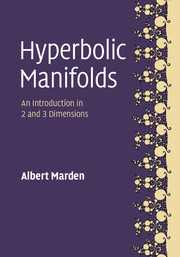Book contents
- Frontmatter
- Dedication
- Contents
- List of Illustrations
- Preface
- 1 Hyperbolic space and its isometries
- 2 Discrete groups
- 3 Properties of hyperbolic manifolds
- 4 Algebraic and geometric convergence
- 5 Deformation spaces and the ends of manifolds
- 6 Hyperbolization
- 7 Line geometry
- 8 Right hexagons and hyperbolic trigonometry
- Bibliography
- Index
5 - Deformation spaces and the ends of manifolds
Published online by Cambridge University Press: 05 January 2016
- Frontmatter
- Dedication
- Contents
- List of Illustrations
- Preface
- 1 Hyperbolic space and its isometries
- 2 Discrete groups
- 3 Properties of hyperbolic manifolds
- 4 Algebraic and geometric convergence
- 5 Deformation spaces and the ends of manifolds
- 6 Hyperbolization
- 7 Line geometry
- 8 Right hexagons and hyperbolic trigonometry
- Bibliography
- Index
Summary
Our work in the earlier chapters, especially our understanding of the structure of geometrically finite manifolds, has prepared the ground for understanding the results that will be presented here, without most proofs. At center stage are the three fundamental conjectures, now theorems, concerning the structure of hyperbolic manifolds with finitely generated fundamental groups but which are not geometrically finite: the Tameness Theorem, Ending Lamination Theorem and Density Theorem.
The chapter begins with a study of the representation variety. We go on to discuss deformation spaces of geometrically finite groups and degeneration of their boundaries. This requires the understanding of the topology of geometrically infinite ends provided by the Tameness Theorem. Once we know the topology we are in the position to understand their geometry. This is what is explained by the Ending Lamination Theorem: In place of the Riemann surface boundaries of geometrically finite groups, the geometrically infinite ends turn out to be degenerated Riemann surfaces, the surfaces being crunched up into “ending laminations”. To complete the picture, the Density Theorem tells us that geometrically finite groups are dense in the set of all finitely generated kleinian groups.
The chapter closes with a discussion of the new results on Cannon-Thurston mappings which lead to the affirmation of the vexing old question whether connected limit sets are also locally connected.
The representation variety
Suppose G = 〈g1, g2, …, gr 〉 is a finitely generated kleinian group (without elliptics), that is G is isomorphic to the fundamental group of M(G). By the Scott–Shalen theorem, there are a finite number of relations ﹛Rk(g1, …, gr) = id﹜, each of which is a word in the generators, such that any relation in the group is a consequence of these.
If we vary the entries in the generating matrices ﹛gi ﹜ we will get a new set of Möbius transformations. The group generated by the new set will be a homomorphic image of G if and only if the new set of generators
satisfy the same relations. These are algebraic equations in the matrix entries.
- Type
- Chapter
- Information
- Hyperbolic ManifoldsAn Introduction in 2 and 3 Dimensions, pp. 276 - 370Publisher: Cambridge University PressPrint publication year: 2016

